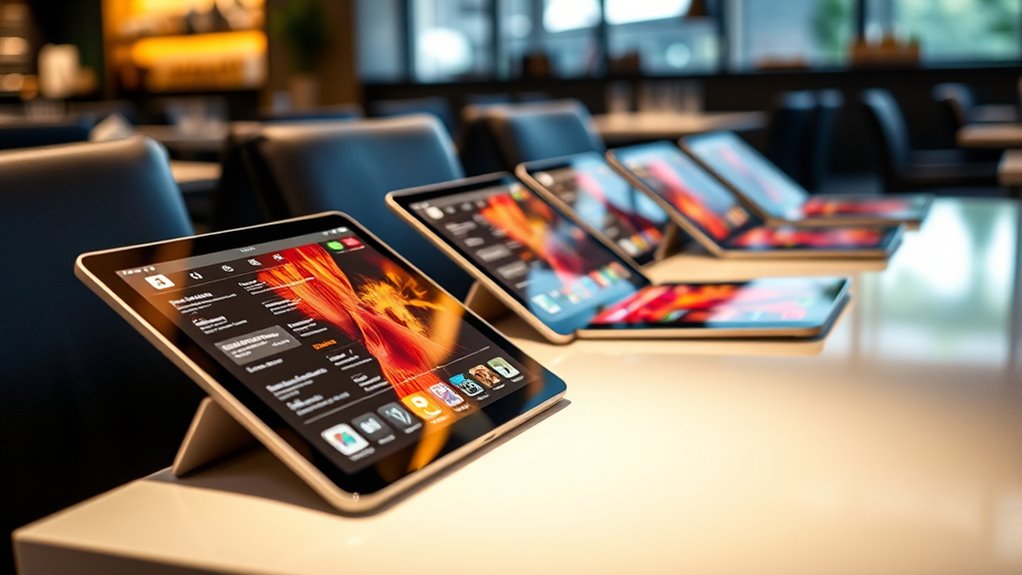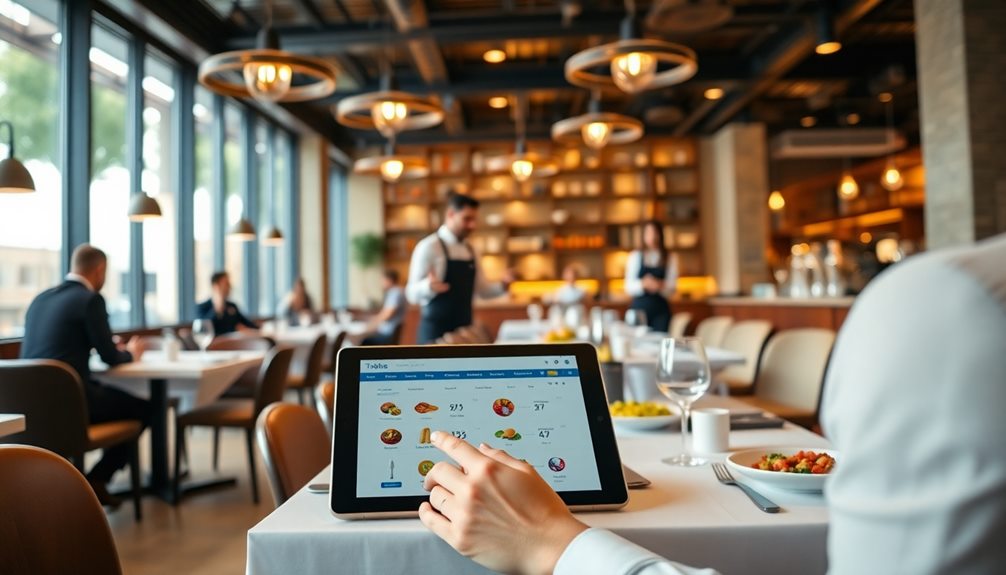To implement table-side ordering tablets effectively, start by evaluating your restaurant’s needs and goals, such as improving speed or accuracy. Choose durable hardware and user-friendly software compatible with your existing systems. Plan your layout and ensure strong Wi-Fi and charging stations are in place. Train your staff thoroughly and monitor system performance during rollout. Gathering feedback helps refine the setup. If you stick with these steps, you’ll be well on your way to a smooth deployment and ongoing success.
Key Takeaways
- Conduct a thorough needs assessment to ensure tablets improve speed, accuracy, and customer experience while addressing current operational challenges.
- Select durable, user-friendly hardware and compatible software with features like real-time order tracking and secure payment options.
- Develop comprehensive staff training programs, including demonstrations, guides, and phased deployment for smooth adoption.
- Optimize Wi-Fi coverage, device placement, charging stations, and security measures to support reliable and secure tablet operations.
- Continuously monitor system performance, gather staff and customer feedback, and implement incremental updates for ongoing improvement.
Assessing Your Restaurant’s Needs and Goals
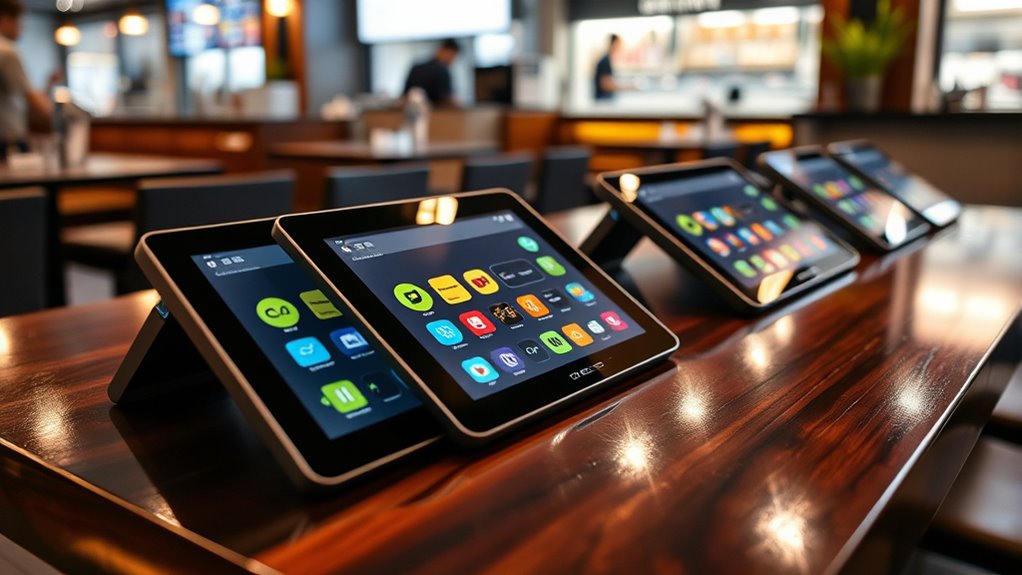
Before investing in table-side ordering tablets, you need to clearly identify your restaurant’s needs and goals. Consider how this technology will improve your operations—are you aiming to speed up service, reduce errors, or enhance customer experience? Think about your current challenges and whether tablets can address them effectively. Assess your staff’s familiarity with digital tools and whether they’ll need training. Determine if your menu layout will translate well to a tablet interface and if your space allows for easy tablet access at each table. Clarify your main objectives, such as increasing table turnover or gathering customer feedback. Additionally, review your privacy policy to ensure compliance with data collection practices. By understanding these needs and goals upfront, you can make informed decisions that align with your restaurant’s overall vision.
Selecting the Right Hardware and Software Solutions
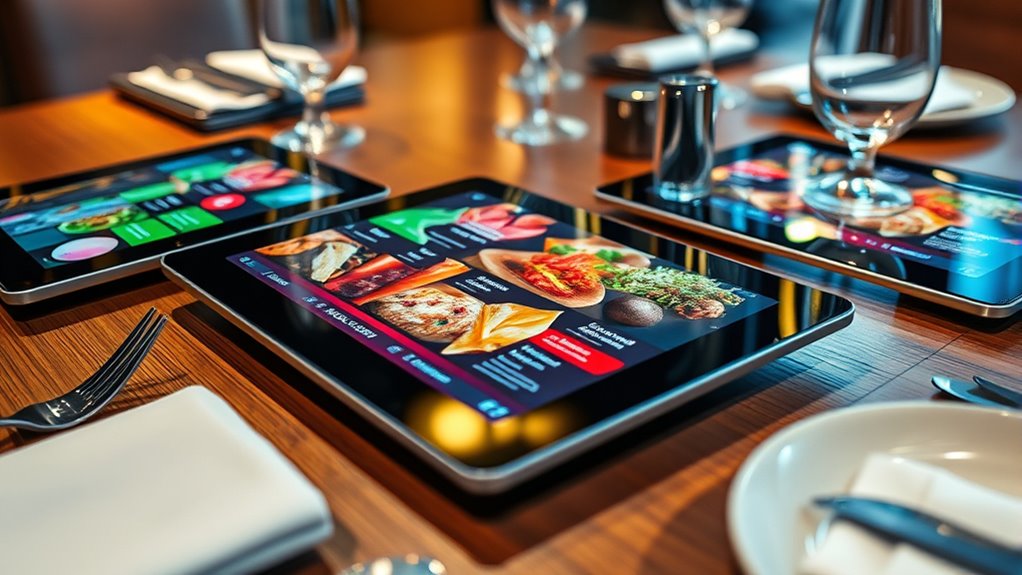
Choosing the right hardware and software solutions is essential to guarantee your table-side ordering system runs smoothly and effectively. Start by evaluating your restaurant’s size, menu complexity, and customer volume. For hardware, opt for durable tablets with long battery life and easy portability, ensuring staff can serve efficiently. Consider rugged devices if your environment is busy or cluttered. For software, select a user-friendly platform that integrates seamlessly with your existing POS and kitchen systems. Look for features like real-time order tracking, customizable menus, and secure payment options. Also, prioritize vendors with reliable support and regular updates. By matching hardware durability with software functionalities tailored to your operations, you’ll create a streamlined experience for staff and guests alike. Additionally, understanding the essential features of your system can help optimize overall efficiency.
Planning the Layout and Infrastructure Setup
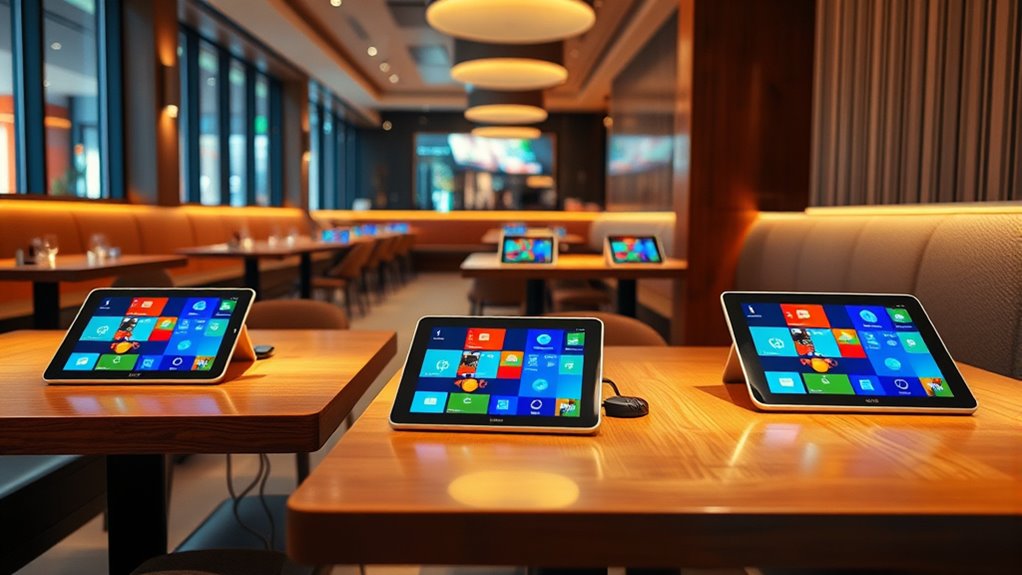
Effective planning of the layout and infrastructure setup is essential to guaranteeing your table-side ordering system operates smoothly. You need to contemplate how devices will be distributed, connected, and maintained to optimize efficiency and reliability. Start by mapping your restaurant’s physical space to identify strategic locations for tablets and charging stations. Next, evaluate your network infrastructure to ensure strong Wi-Fi coverage and minimal interference. Address power sources by installing sufficient outlets and backup options to prevent disruptions. Finally, plan for security measures like secure mounts and network access controls to protect both hardware and sensitive data.
- Map device placement for easy access and minimal clutter
- Ensure robust Wi-Fi coverage throughout the venue
- Establish reliable power and backup solutions
- Implement security protocols to safeguard the system
Training Staff for Smooth Adoption
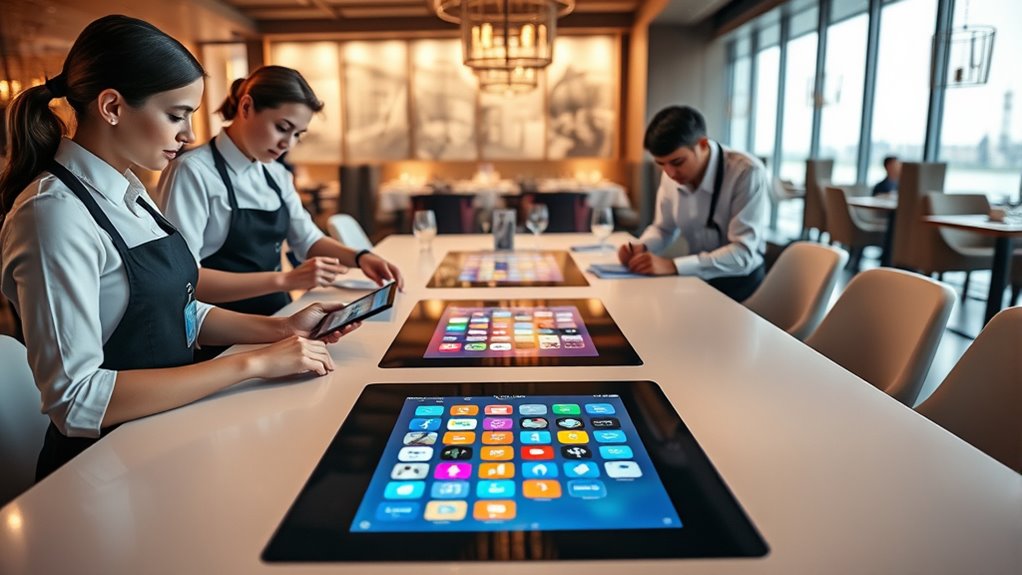
To guarantee your staff adopts the table-side ordering system smoothly, extensive training is essential. Begin by providing thorough demonstrations of how to use the tablets, ensuring they understand each feature and function. Encourage hands-on practice so staff gain confidence and can troubleshoot common issues. Emphasize the importance of delivering excellent customer service alongside the new technology. Create clear, step-by-step guides tailored to your specific setup, and make these easily accessible. Regularly reinforce training through refresher sessions and updates as the system evolves. Address questions and concerns promptly to foster acceptance and reduce resistance. Additionally, understanding website privacy policies can help staff navigate customer interactions responsibly. By investing time in thorough training, you ensure your team feels prepared, reducing errors and enhancing the overall dining experience for your guests.
Integrating Tablets With Existing POS and Management Systems
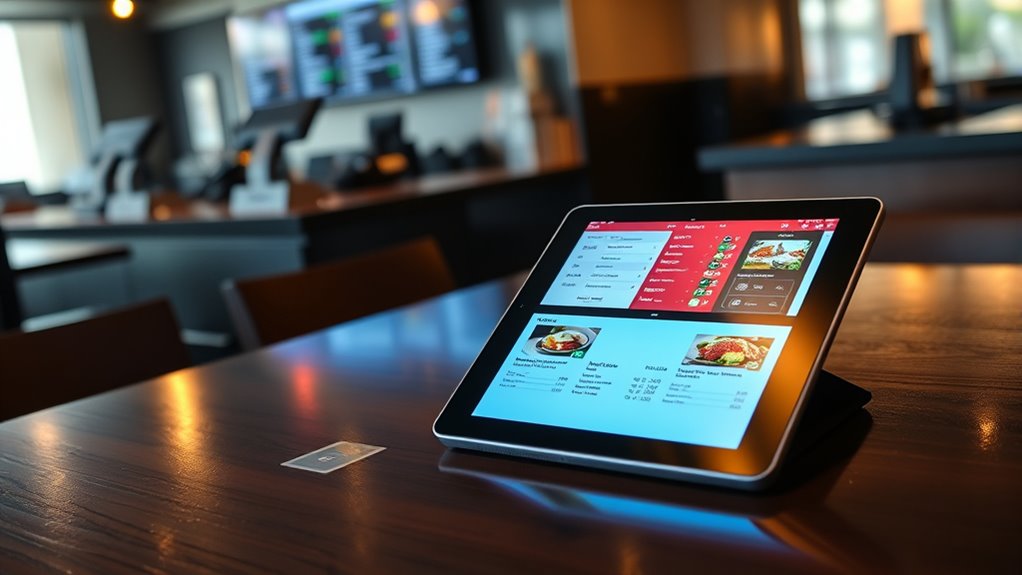
Integrating tablets with your existing POS and management systems is essential for streamlining operations and guaranteeing data consistency. Proper integration allows real-time updates, reduces errors, and improves efficiency. To achieve seamless integration, focus on these key areas:
- Choose compatible hardware and software to ensure smooth communication between devices.
- Use APIs or middleware that facilitate data exchange without manual input.
- Sync inventory and menu updates automatically to prevent discrepancies.
- Implement secure data transfer protocols to protect customer and business information.
- Incorporate data accuracy measures to maintain reliable information across all platforms.
Launching and Monitoring the Implementation
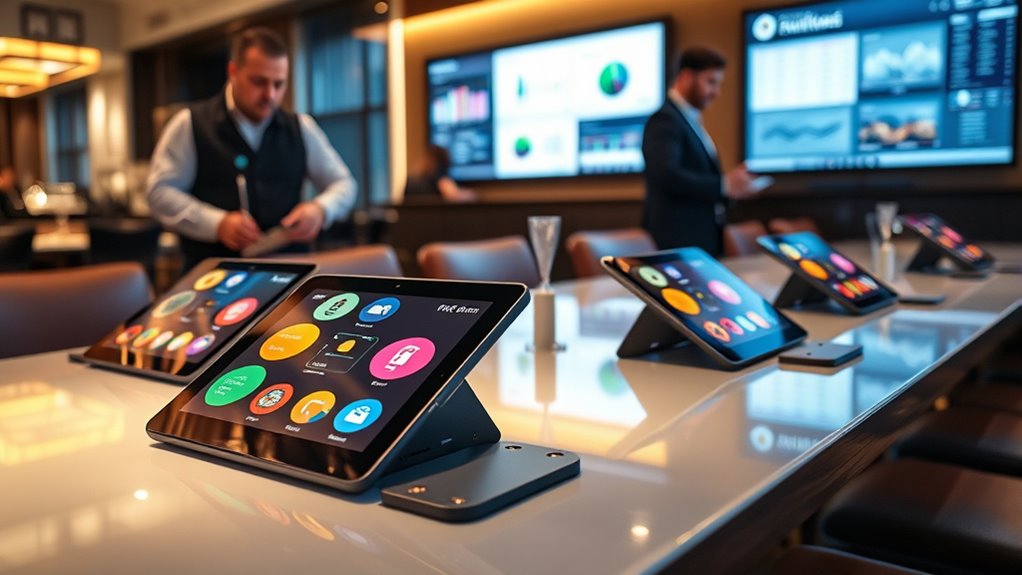
How can you guarantee a smooth launch and ongoing success for your tablet ordering system? Start by planning a phased rollout, training staff thoroughly, and testing the system in real conditions. During launch, monitor performance closely, address issues promptly, and gather staff feedback to identify bottlenecks. Use the following table to track progress:
| Step | Action | Goal |
|---|---|---|
| Staff Training | Conduct hands-on sessions | Ensure confidence and competence |
| System Testing | Run pilot orders | Detect bugs early |
| Performance Monitoring | Track order accuracy and speed | Maintain service quality |
| Issue Resolution | Address technical glitches quickly | Minimize downtime |
| Feedback Collection | Gather staff and customer input | Improve ongoing processes |
This approach keeps you proactive, ensuring your system runs smoothly from day one. Additionally, implementing meditation techniques can help staff stay calm and focused during stressful launch periods.
Gathering Feedback and Making Continuous Improvements
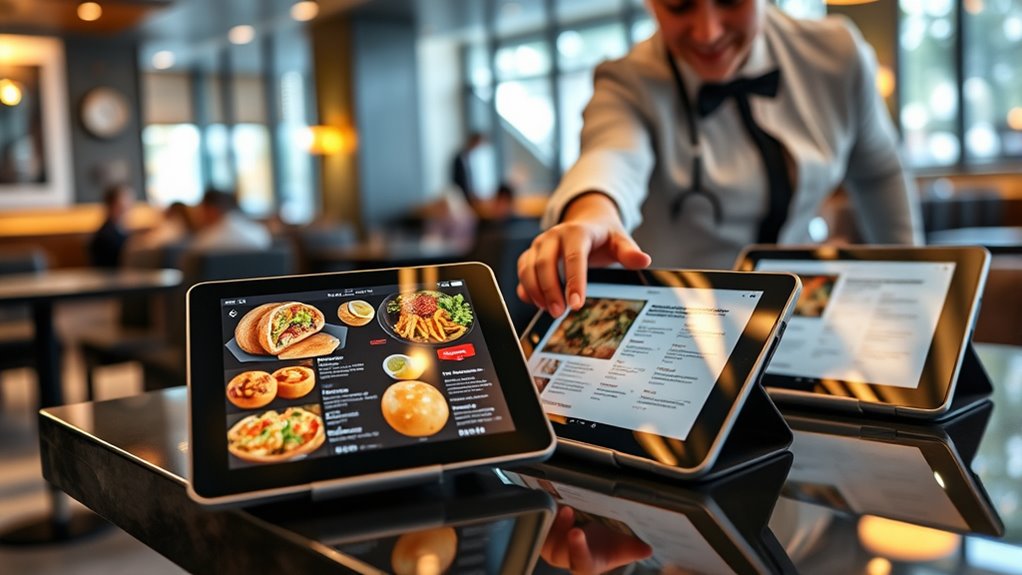
To keep your table-side ordering tablets running smoothly, you need to regularly gather user feedback and track responses. This will help you identify what’s working and what needs refinement. Using an iterative approach ensures your system evolves effectively, meeting both staff and customer needs. Incorporating feedback strategies can further enhance your ability to adapt and improve over time.
Monitoring User Responses
Are you effectively capturing user feedback to improve the tablet ordering experience? Monitoring responses helps identify pain points and opportunities for enhancement. To do this effectively:
- Track real-time user interactions to spot patterns or issues quickly.
- Collect direct feedback through brief surveys or prompts after orders.
- Analyze error reports and support tickets for recurring problems.
- Observe customer behavior and engagement metrics to understand usage trends.
- Stay informed about local legal resources that could influence support options or troubleshooting approaches.
Iterative Enhancement Strategies
Building on insights gained from monitoring user responses, implementing iterative enhancement strategies allows you to refine the tablet ordering experience continuously. Collect feedback regularly, analyze patterns, and identify pain points. Prioritize improvements based on impact and feasibility. Test changes through small updates, observe user reactions, and gather new insights. This cycle helps you adapt quickly and optimize usability. Use the following table to organize your approach:
| Feedback Source | Action | Goal |
|---|---|---|
| Customer reviews | Gather and analyze comments | Identify common issues |
| Usage analytics | Track feature engagement | Highlight underused features |
| Staff observations | Note operational challenges | Improve workflow efficiency |
| Post-update surveys | Measure satisfaction levels | Validate improvements |
Additionally, incorporating feedback collection methods can help you better understand user preferences and improve overall satisfaction. This process ensures your tablet system evolves effectively, enhancing user satisfaction over time.
Frequently Asked Questions
How Secure Are Tablet Transactions Against Data Breaches?
You might wonder how secure your tablet transactions are against data breaches. Generally, these systems use encryption, secure login protocols, and regular updates to protect sensitive information. When you follow best practices, like using strong passwords and staying current with software patches, you markedly reduce risks. While no system is completely invulnerable, proper security measures make tablet transactions quite safe, giving you peace of mind during your ordering process.
What Are the Best Practices for Tablet Sanitation and Hygiene?
Think of your tablets as the heartbeat of your service, needing clean flow to keep everything alive. You should regularly wipe screens with disinfectant wipes approved for electronics, avoiding harsh chemicals that can damage devices. Encourage staff to wash hands before handling tablets, and store them in sanitized cases when not in use. These steps guarantee your tablets stay hygienic, safeguarding both your staff and guests from germs and cross-contamination.
How Can Tablets Be Customized for Different Menu Offerings?
You can customize tablets for different menu offerings by updating software with new images, descriptions, and prices regularly. Use user-friendly interfaces that highlight specific categories or specials, making navigation easier for your staff and guests. Incorporate customizable templates and allow quick access to seasonal or promotional items. Training your team to manage these updates guarantees your menu stays current, appealing, and tailored to your restaurant’s evolving offerings.
What Is the Typical Return on Investment Timeline?
Ever wonder if tablets are worth it? Typically, you see a return on investment within 6 to 12 months, depending on your restaurant size and sales volume. You’ll streamline order accuracy, speed up service, and boost efficiency, which all contribute to faster profit recovery. Are you ready to embrace technology that transforms your dining experience? With proper implementation, tablets quickly become a valuable asset, paying for themselves in record time.
How Do Tablets Impact Table Turnover Rates and Customer Satisfaction?
You’ll likely see faster table turnover rates as tablets streamline ordering and reduce wait times, allowing you to serve more guests efficiently. Customers appreciate the quick, accurate service, boosting satisfaction and encouraging repeat visits. Tablets also minimize errors and enhance communication between staff and diners. As a result, your restaurant benefits from increased revenue and improved guest experiences, making the investment worthwhile in the long run.
Conclusion
By carefully following these steps, you’ll smoothly implement table-side ordering tablets and stay ahead of the curve. Remember, this isn’t your grandpappy’s ink-stained menu—technology’s the future. Embrace the change and keep refining your setup like a well-tuned steam engine. With patience and feedback, you’ll create a seamless dining experience that keeps customers satisfied and your staff efficient. Don’t be a laggard—get on board now and watch your restaurant thrive!
